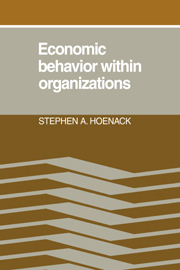Book contents
- Frontmatter
- Contents
- Preface
- 1 Introduction
- 2 Definitions and determinants of employees' discretion over an organization's resources and production
- 3 Employees' resource diversions and employers' imposition of resource responsibility
- 4 Short-run resource allocation under fixed budgets
- 5 Short-run resource allocation in response to demand: the cases of an employee, a private corporation, and a private nonprofit organization
- 6 Legislative demand and short-run price and output of the public organization
- 7 Employees' investment behavior and implications for suborganization
- 8 Equilibrium behavior of public and private organizations in the first long run
- 9 The demand and supply of nonmarket resource allocation
- 10 A brief summary and proposed directions for further work
- Notes
- References
- Core definitions
- Index
8 - Equilibrium behavior of public and private organizations in the first long run
Published online by Cambridge University Press: 05 November 2011
- Frontmatter
- Contents
- Preface
- 1 Introduction
- 2 Definitions and determinants of employees' discretion over an organization's resources and production
- 3 Employees' resource diversions and employers' imposition of resource responsibility
- 4 Short-run resource allocation under fixed budgets
- 5 Short-run resource allocation in response to demand: the cases of an employee, a private corporation, and a private nonprofit organization
- 6 Legislative demand and short-run price and output of the public organization
- 7 Employees' investment behavior and implications for suborganization
- 8 Equilibrium behavior of public and private organizations in the first long run
- 9 The demand and supply of nonmarket resource allocation
- 10 A brief summary and proposed directions for further work
- Notes
- References
- Core definitions
- Index
Summary
In the analysis of the short run it was assumed that current investment behavior has no effect on the same time period's resource allocation. Over longer periods an organization's tangible and intangible capital resources are altered both by employees' investments (analyzed in Chapter 7) and by the funding authority's investments. This and the next chapter analyze price and output determination for public and private organizations during time periods long enough for the investments of employees and the funding authority to influence the outcome.
We have seen that an employee's investments can increase the resource diversions that are allowed by the responsibility facing him. However, an organization's “funding limit” constrains the combined resource diversions of all of its employees, regardless of the amounts allowed by responsibility. Thus, we shall consider the effects of employees' investments within two possibly overlapping time horizons. In the “first long run,” employees' investments can have the fullest possible impact on the resource diversions allowed by responsibility within the funding limit. During this time period an organization's funding limit cannot be changed as a result of a merger with another organization or a change in its status as a private corporation, private nonprofit organization, or a public organization. However, because these changes affect funding limits substantially, they are often objects of employees' investments. Such investments are analyzed in the “second long-run” analysis of Chapter 9.
This chapter first considers the funding limit in each type of organization and then analyzes price and output determination in the first long run.
- Type
- Chapter
- Information
- Economic Behaviour within Organizations , pp. 210 - 229Publisher: Cambridge University PressPrint publication year: 1983



